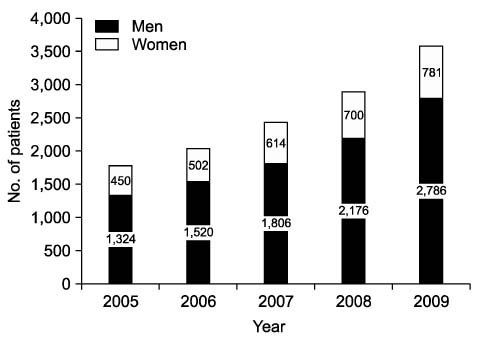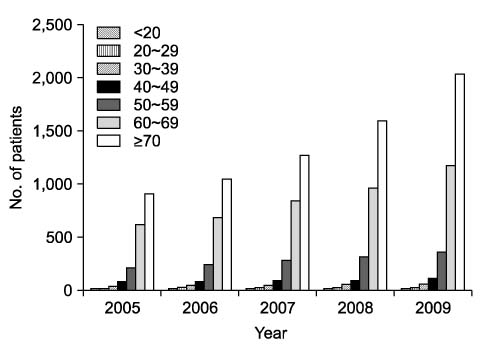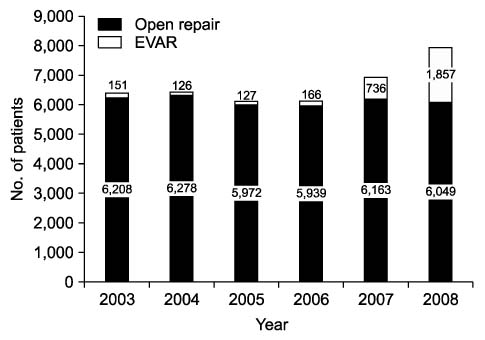J Korean Surg Soc.
2011 Feb;80(2):125-130. 10.4174/jkss.2011.80.2.125.
Investigation of Current Trend of AAA Treatment in Korea
- Affiliations
-
- 1Department of Surgery, Samsung Medical Center, Sungkyunkwan University School of Medicine, Seoul, Korea. ywkim@skku.edu
- 2Cardiac and Vascular Center, Samsung Medical Center, Sungkyunkwan University School of Medicine, Seoul, Korea.
- KMID: 2117120
- DOI: http://doi.org/10.4174/jkss.2011.80.2.125
Abstract
- PURPOSE
To know the current trend of the annual number of AAA patients in Korea and treatment modality, we attempted to investigate the numbers of patients diagnosed with AAA and the number of patients who underwent open or endovascular treatment of AAA in Korea during the last 6 years.
METHODS
To investigate the number of AAA patients, we searched for ruptured AAA and AAA without description of rupture disease from the database of Health Insurance Reimbursement Association (HIRA) by searching the disease code of HIRA I71.3 (ruptured AAA) and I71.4 (AAA without description of rupture) during the period between 2003 and 2009. To investigate the number of patients who underwent treatment for AAA, we searched for code O 2036, O 2034, O 0223, O 0224 (open surgical repair) and M 6612 (endovascular aneurysm repair, EVAR). To discern the number of AAA-related deaths in Korea during the same period, we depended on the database of the Statistics Korea.
RESULTS
We found that the number of AAA patients and treatment of AAA were rapidly increasing recently after the inception of the reimbursement for EVAR by the HIRA. But the number of AAA-related deaths did not significantly change during the same period in Korea.
CONCLUSION
After observing that the number of patients with AAA and its treatment rapidly increased while the number of AAA-related death did not increase, we can assume that it is the result of increase of patients detection rather than that of prevalence of AAA and also think that many AAA patients are still under-detected in Korea. To cope with the increasing number of AAA patients and to facilitate detection of hidden AAA patients, we would like to propose a nationwide screening program of AAA for a selected group of the population.
MeSH Terms
Figure
Cited by 2 articles
-
Case study of abdominal aortic aneurysm screening programs in other countries and feasibility study of a national screening program for South Korea
Sang-Soo Lee, Jin Hyun Joh
J Korean Med Assoc. 2016;59(10):804-812. doi: 10.5124/jkma.2016.59.10.804.Long-term Survival Rates for Patients with Aortic Aneurysm
Shin Yi Jang, Duk-Kyung Kim
J Lipid Atheroscler. 2017;6(1):22-28. doi: 10.12997/jla.2017.6.1.22.
Reference
-
1. Johnston KW, Rutherford RB, Tilson MD, Shah DM, Hollier L, Stanley JC. Suggested standards for reporting on arterial aneurysms. Subcommittee on Reporting Standards for Arterial Aneurysms, Ad Hoc Committee on Reporting Standards, Society for Vascular Surgery and North American Chapter, International Society for Cardiovascular Surgery. J Vasc Surg. 1991. 13:452–458.2. Gillum RF. Epidemiology of aortic aneurysm in the United States. J Clin Epidemiol. 1995. 48:1289–1298.3. Wilmink AB, Hubbard CS, Day NE, Quick CR. The incidence of small abdominal aortic aneurysms and the change in normal infrarenal aortic diameter: implications for screening. Eur J Vasc Endovasc Surg. 2001. 21:165–170.4. Lederle FA, Johnson GR, Wilson SE, Chute EP, Hye RJ, Makaroun MS, et al. Aneurysm Detection and Management Veterans Affairs Cooperative Study Investigators. The aneurysm detection and management study screening program: validation cohort and final results. Arch Intern Med. 2000. 160:1425–1430.5. Fleming C, Whitlock EP, Beil TL, Lederle FA. Screening for abdominal aortic aneurysm: a best-evidence systematic review for the U.S. Preventive Services Task Force. Ann Intern Med. 2005. 142:203–211.6. Cosford PA, Leng GC. Screening for abdominal aortic aneurysm. Cochrane Database Syst Rev. 2007. CD002945.7. Heller JA, Weinberg A, Arons R, Krishnasastry KV, Lyon RT, Deitch JS, et al. Two decades of abdominal aortic aneurysm repair: have we made any progress? J Vasc Surg. 2000. 32:1091–1100.8. Lesperance K, Andersen C, Singh N, Starnes B, Martin MJ. Expanding use of emergency endovascular repair for ruptured abdominal aortic aneurysms: disparities in outcomes from a nationwide perspective. J Vasc Surg. 2008. 47:1165–1170. discussion 70-1.9. Ashton HA, Buxton MJ, Day NE, Kim LG, Marteau TM, Scott RA, et al. The Multicentre Aneurysm Screening Study (MASS) into the effect of abdominal aortic aneurysm screening on mortality in men: a randomised controlled trial. Lancet. 2002. 360:1531–1539.10. Lee ES, Pickett E, Hedayati N, Dawson DL, Pevec WC. Implementation of an aortic screening program in clinical practice: implications for the Screen For Abdominal Aortic Aneurysms Very Efficiently (SAAAVE) Act. J Vasc Surg. 2009. 49:1107–1111.11. 2007 Statistics for Elderly Population. 2007. Statistics Korea.14. Parodi JC, Palmaz JC, Barone HD. Transfemoral intraluminal graft implantation for abdominal aortic aneurysms. Ann Vasc Surg. 1991. 5:491–499.15. Ten Bosch JA, Teijink JA, Willigendael EM, Prins MH. Endovascular aneurysm repair is superior to open surgery for ruptured abdominal aortic aneurysms in EVAR-suitable patients. J Vasc Surg. 2010. 52:13–18.16. Kim YW, Min SK, Koh YB, Kim SN, Park JS, Moon IS, et al. Report of nation-wide questionnaire survey for abdominal aortic aneurysm treatment in Korea. J Korean Soc Vasc Surg. 2005. 21:10–15.
- Full Text Links
- Actions
-
Cited
- CITED
-
- Close
- Share
- Similar articles
-
- A Clinical Consideration of Abdominal Aortic Aneurysm Rupture
- Current Endovascular Treatment of Abdominal Aortic Aneurysm
- Indications and Short-term Results of Open Surgical Repair of Abdominal Aortic Aneurysm in an Endovascular Era
- Successful Endovascular Aneurysm Repair for a Ruptured Abdominal Aortic Aneurysm
- Management of Small AAA/New Attempts to Prevent Expansion or Rupture of AAA







